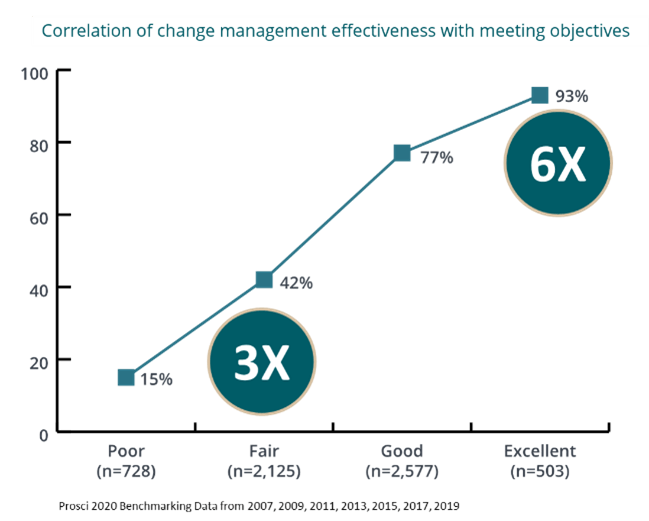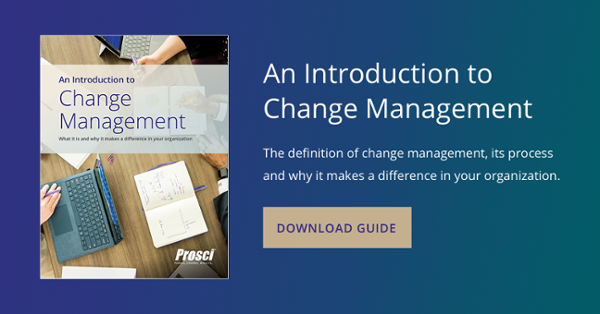It is no surprise that we are seeing organisations face increasing amounts of change. These are often more complex changes and arising at a faster pace than perhaps ever before. Digital transformation, pandemic response, labour market dynamics and generational shifts are just some of the factors driving tremendous change in the workplace. Since the industrial revolution we have seen how successful organisational change has depended to a greater or lesser degree on people adopting a change. Return on investment and benefits delivery in the complexity of the twenty-first century workplace depend more and more on effective change management. Business results depend on as many people as possible successfully transitioning from the current to future state in a change process.
Many organisations recognise this need to manage the people side of change. For many there is an urgent necessity to address the scope and scale of change, mitigate change saturation and avoid the negative human and business consequences of change fatigue. However, for some organisations this is not enough.
Some are seeing not just the opportunity arising from individual change projects or initiatives but the opportunity that comes from changing how we change. With Enterprise Change Management, organisations can take advantage of this opportunity to create more resilient, agile organisations and drive competitive advantage. So what are they doing that other organisations are not?
How is Enterprise Change Management different?
Let's firstly make a clear distinction between organisational change management applied at the project or initiative level and what our partner Prosci terms Enterprise Change Management or ECM. Prosci, defines project-based, organisational change management as "the application of a structured process and set of tools for leading the people side of change to achieve a desired outcome.” Over twenty years of research by Prosci has demonstrated the improved outcomes seen when effective change management is applied on a project or initiative. It does so by better enabling individuals impacted by the change to make their own individual transitions, resulting in them adopting and use the project's solutions successfully.
ECM on the other hand brings a strategic intent to embed change management discipline into how change is delivered across the organisation. Some of the expected outcomes include reduced change saturation, enhanced agility and improved portfolio management. For this to happen, however, we need to develop change management competencies across the organisation while making sure we consistently apply effective change management on our projects.
Typically we would expect to see 3 key elements present where an organisation has developed an ECM capability.
1. A common approach including methodology, tools and processes
This element requires the intentional and repetitive application of change management. We are moving away from ad-hoc application, often dependent on the enthusiasm or experience of individuals. Instead we see the consistent application of a common change management process and set of tools for managing the people side of change.
2. A leadership competency at every level of the organisation
Leading change, whether as a frontline supervisor, middle manager or senior executive, places distinct demands on us compared to leading business-as-usual. To deliver successful change requires leaders to perform specific roles, underpinned by the necessary competencies. Above all, it depends on leaders embracing their role as leaders of change. Developing the necessary competencies, at scale across the organisation, requires training, coaching and support on the job.
3. A strategic capability evidenced by increased change readiness, agility and responsiveness
As an organisation embeds change management discipline and develops change leadership competence this third element emerges. The organisation is increasingly "change-ready" both practically and culturally.

How to approach developing ECM capability
We shouldn't underestimate the challenge of embedding ECM in an organisation. It can be a significant endeavour in its own right, and it will take time and investment to deliver. However, before you start consider your own and your stakeholders' perspective on change management. Successful ECM deployment involves viewing it and treating it differently.
Treat is as a project
As with any project, you need a structured approach to plan and implement your ECM project. You will of course need to design an ECM solution that fits the needs, constraints and culture of your organisation. Treating your ECM journey as a project, we call it Project ECM, helps bring your organisation's project management capability to bear on the challenge.
Treat it as a change
In changing 'how we do change', a lot of people in your organisation may be required to adopt new behaviours and ways of working, develop new skills and challenge old habits or routines. The need to manage the people side of change is just as relevant to the success of Project ECM as any other. Applying change management to Project ECM will help ensure you are paying attention to key elements such as sponsorship, communications and competency building, for example.
Treat is as a top-down effort
In every Prosci Best Practices in Change Management study over twenty years, the number one contributor to change success has been active and visible sponsorship from senior leaders. As an organisation-wide endeavour, Project ECM must be driven from the top. You need to have an effective primary sponsor, a strong sponsor coalition and communication directly from the senior leaders to convey the 'why' for enterprise change management.
Why enterprise change management?
Why should your organisation consider embarking on the journey to build this capability? Here are three reasons to consider.
1. Cumulative benefits
Prosci Best Practices in Change Management studies show a clear association between the application of change management on a project and its likelihood of success. The better the change management, the more likely your project is to achieve objectives, finish on schedule and stay on budget. If your organisation moves from ad-hoc application to consistent and effective change management across its project portfolio these benefits can be multiplied.

The opposite can also be seen with poorly managed change leading to reduced productivity, resistance to change, reduced employee engagement, slow adoption or poor usage. All these factors lead to reduced and/or delayed project benefits. The story of change in the organisation has another example to reinforce why an idea "won't work here", making future changes more challenging. The cumulative negative impacts of many poorly managed changes are often not appreciated and may not become apparent until a tipping point is reached or a critical project runs into trouble.
2. Economies of learning
Effective change management gives you a better chance of reaching your project goals, delivering benefits and a return on investment. When organisations successfully develop an Enterprise Change Management capability it typically requires consistent application of change management discipline, including a single approach or methodology. By consistently using the same techniques, tools and processes you have a dependable approach every time. You are creating a common language that the entire business understands, no longer reinventing the wheel every project, and capturing lessons learned for continuous improvement.
3. External drivers of change
The pressure on organisations to keep up with constant change seems to be increasing by the day. In the face of a tsunami of change, building enterprise change management capability is no longer a nice-to-have but a necessity if organisations expect to survive, innovate and grow. Given the nature of many changes organisations are undertaking, or will face in the next few years, they cannot risk failure. How agile your organisation is will differentiate it from its peers and may form the basis of a sustainable competitive advantage.
Summary
Many organisations already recognise the impact of change management on adoption and usage for critical projects. Increasingly, they see the necessity in today's ever-changing environment to broaden its application and embed an ECM capability. They are making change management a core competency while positioning their organisation to enjoy cumulative benefits and competitive advantages. Is your organisation ready to embark on the journey?

Written By Angelo McNeive
Angelo McNeive is Co-founder and Head of Change Practice for STEPSTONE Consulting. He helps organisations become more human places to work by developing their enterprise change and project management capabilities. Angelo is a Chartered Psychologist in Ireland and a Chartered Fellow of the CIPD.


